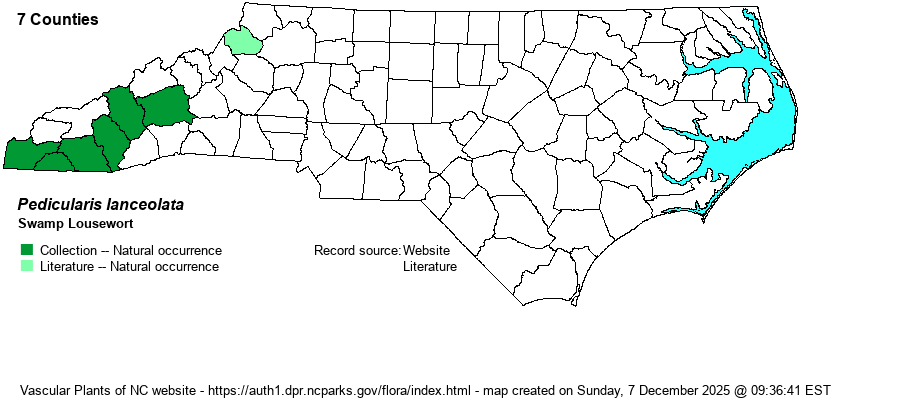| Author | Michaux | |
| Distribution | Though a Northern species, in NC it is limited nearly to the southern half of the Mountains, though there is an historical record from the northern Mountains (Watauga County).
This Northern species ranges from MA and ND south to western NC, extreme northern GA, and northern AR. | |
| Abundance | Very rare in the southern Mountains, with about four or five extant records, according to the NCNHP database (and about five additional historical records). Now of historical occurrence north of Haywood and Buncombe counties. This is a State Threatened species. | |
| Habitat | This is a wetland species that requires high pH soil in mostly sunny conditions, a rare to very rare combination. In NC it is found mainly in wet meadows, but also is found in sunny seepages, springs, and swampy openings. It does not occur in bogs (acidic soil natural community). |
| Phenology | Blooms in late summer, as opposed to spring when P. canadensis blooms. It is in flower from August to October, and fruits from September to October. | |
| Identification | Unlike the familiar and rather short P. canadensis, P. lanceolata has been seen by very few people in NC. It has a rather tall stem, unbranched or with a very few short branches, and reaching about 2 feet tall. In this species, the basal leaves are insignificant, and the stem leaves are paired, opposite, about 2 inches long and about 2/3-inch wide, but instead of being deeply dissected into numerous narrow lobes, each one has only shallow notches, such that the numerous lobes are low and rounded. The inflorescence is a terminal spike, rarely in leaf axils, and is somewhat similar to that of P. canadensis except that the flowers are paler yellow, are somewhat shorter (only about 4/5-inch long), and most are oriented horizontally in a taller than wide cluster. The cluster in P. canadensis is rounded, with flowers oriented in all directions outward from a central point. All of this probably does not matter, in that the two species bloom about four months apart -- though being familiar with the flower shape and cluster of P. canadensis will certainly help provide a search image to locate this very rare species. Unfortunately, because it is a "wet meadow" type of species, rather than a bog species, it tends to reside in habitats that are not often conservation targets, as bogs are. | |
| Taxonomic Comments | None
| |
| Other Common Name(s) | Swamp Wood-betony, Marsh Betony | |
| State Rank | S1 | |
| Global Rank | G4 | |
| State Status | T | |
| US Status | | |
| USACE-agcp | FACW link |
| USACE-emp | FACW link |

